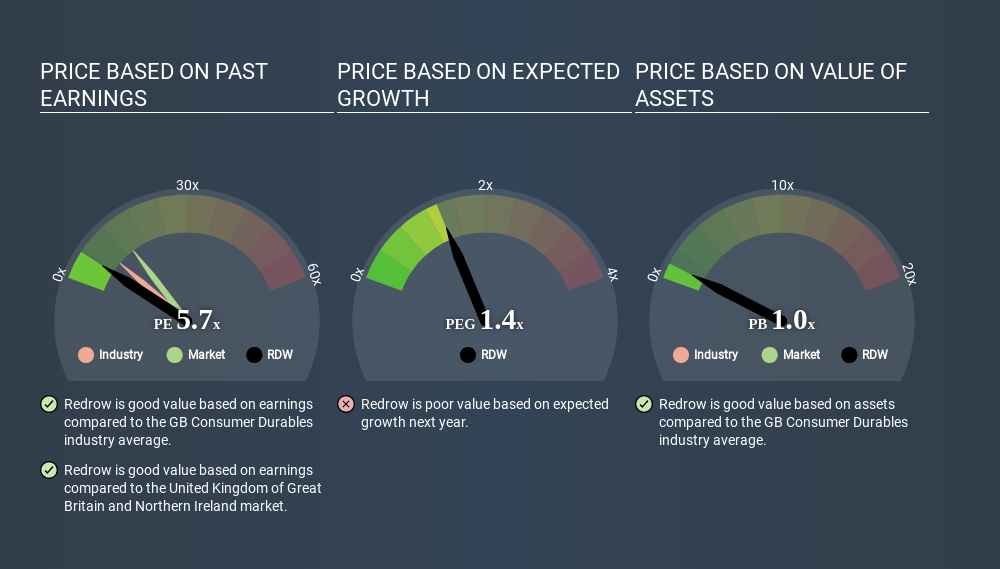- United Kingdom
- /
- Consumer Durables
- /
- LSE:RDW
A Rising Share Price Has Us Looking Closely At Redrow plc's (LON:RDW) P/E Ratio

Those holding Redrow (LON:RDW) shares must be pleased that the share price has rebounded 31% in the last thirty days. But unfortunately, the stock is still down by 38% over a quarter. But shareholders may not all be feeling jubilant, since the share price is still down 21% in the last year.
Assuming no other changes, a sharply higher share price makes a stock less attractive to potential buyers. In the long term, share prices tend to follow earnings per share, but in the short term prices bounce around in response to short term factors (which are not always obvious). So some would prefer to hold off buying when there is a lot of optimism towards a stock. Perhaps the simplest way to get a read on investors' expectations of a business is to look at its Price to Earnings Ratio (PE Ratio). A high P/E implies that investors have high expectations of what a company can achieve compared to a company with a low P/E ratio.
Check out our latest analysis for Redrow
Does Redrow Have A Relatively High Or Low P/E For Its Industry?
We can tell from its P/E ratio of 5.66 that sentiment around Redrow isn't particularly high. We can see in the image below that the average P/E (8.9) for companies in the consumer durables industry is higher than Redrow's P/E.

Redrow's P/E tells us that market participants think it will not fare as well as its peers in the same industry. Since the market seems unimpressed with Redrow, it's quite possible it could surprise on the upside. You should delve deeper. I like to check if company insiders have been buying or selling.
How Growth Rates Impact P/E Ratios
Earnings growth rates have a big influence on P/E ratios. If earnings are growing quickly, then the 'E' in the equation will increase faster than it would otherwise. That means even if the current P/E is high, it will reduce over time if the share price stays flat. And as that P/E ratio drops, the company will look cheap, unless its share price increases.
Redrow saw earnings per share decrease by 5.8% last year. But it has grown its earnings per share by 16% per year over the last five years.
Don't Forget: The P/E Does Not Account For Debt or Bank Deposits
Don't forget that the P/E ratio considers market capitalization. So it won't reflect the advantage of cash, or disadvantage of debt. In theory, a company can lower its future P/E ratio by using cash or debt to invest in growth.
Spending on growth might be good or bad a few years later, but the point is that the P/E ratio does not account for the option (or lack thereof).
How Does Redrow's Debt Impact Its P/E Ratio?
The extra options and safety that comes with Redrow's UK£14m net cash position means that it deserves a higher P/E than it would if it had a lot of net debt.
The Verdict On Redrow's P/E Ratio
Redrow has a P/E of 5.7. That's below the average in the GB market, which is 14.2. Falling earnings per share are likely to be keeping potential buyers away, but the net cash position means the company has time to improve: if so, the low P/E could be an opportunity. What is very clear is that the market has become less pessimistic about Redrow over the last month, with the P/E ratio rising from 4.3 back then to 5.7 today. If you like to buy stocks that could be turnaround opportunities, then this one might be a candidate; but if you're more sensitive to price, then you may feel the opportunity has passed.
When the market is wrong about a stock, it gives savvy investors an opportunity. If it is underestimating a company, investors can make money by buying and holding the shares until the market corrects itself. So this free visualization of the analyst consensus on future earnings could help you make the right decision about whether to buy, sell, or hold.
Of course, you might find a fantastic investment by looking at a few good candidates. So take a peek at this free list of companies with modest (or no) debt, trading on a P/E below 20.
If you spot an error that warrants correction, please contact the editor at editorial-team@simplywallst.com. This article by Simply Wall St is general in nature. It does not constitute a recommendation to buy or sell any stock, and does not take account of your objectives, or your financial situation. Simply Wall St has no position in the stocks mentioned.
We aim to bring you long-term focused research analysis driven by fundamental data. Note that our analysis may not factor in the latest price-sensitive company announcements or qualitative material. Thank you for reading.
About LSE:RDW
Flawless balance sheet, undervalued and pays a dividend.
Similar Companies
Market Insights
Community Narratives



